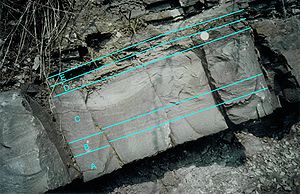
Bouma sequence
Encyclopedia

Turbidity current
A turbidity current is a current of rapidly moving, sediment-laden water moving down a slope through water, or another fluid. The current moves because it has a higher density and turbidity than the fluid through which it flows...
. The Bouma Sequence specifically describes the medium grained variety, which are usually found in the continental slope or rise setting.
The Bouma Sequence is divided into 5 distinct beds labelled A through E, with A being at the bottom and E being at the top; each bed is described by Bouma as having a specific lithology
Lithology
The lithology of a rock unit is a description of its physical characteristics visible at outcrop, in hand or core samples or with low magnification microscopy, such as colour, texture, grain size, or composition. It may be either a detailed description of these characteristics or be a summary of...
(see below). In a real Bouma sequence, some beds may be missing - Bouma describes the ideal sequence.
The beds are:
- E: Muds, ungraded, often bioturbated...
- D: Parallel laminated silts.
- C: Cross laminated sands.
- B: Parallel laminated sands.
- A: Sands and any larger grains the turbidity current was carrying at the time of deposition.
The base of the sandstone, below A, is scoured.

